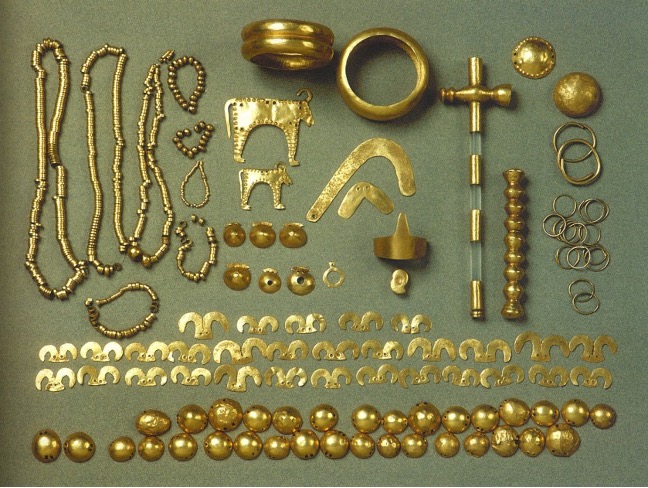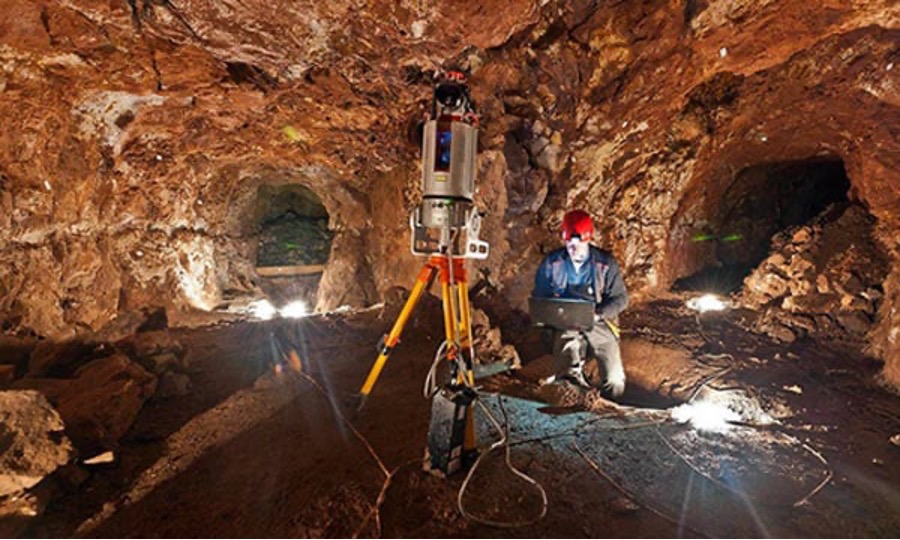When did gold first appear? What role did it play in the emergence of civilizations?
Gold occupies a central place in modern history and, more generally, in the history of mankind. Recent archaeological discoveries have challenged our understanding of the origins of gold in our societies. Gold seems to have appeared with the first cities, hence its title of “first metal”.
Gold's appearance predates that of iron by several millennia, and coincides approximately with that of copper. It has also been established that the precious metal was used by certain civilizations even before the birth of writing. Indeed, writing was partly developed to record loans granted in the form of gold. The history of gold never ceases to amaze, to the point where we may well wonder whether it played a fundamental role in the formation of civilizations... A return to the origins of the eternal metal.
The etymological origins of gold
The chemical symbol for gold is AU, taken from the Latin aurum, itself derived from the name of the Roman goddess Aurora. Aurora symbolized the dawn, the first-fruits of light, and is also the sister of Sol (Sun) and Luna (Moon). In Latin languages, the root of the word aurum has been preserved, as in French (“or”) and Spanish (“oro”). The reference to the goddess Aurora is significant both historically and symbolically. Gold's characteristic yellow color is due to its absorption of blue light, giving off reddish and orange hues. Blue, in some traditions, is linked to dawn, reinforcing the mythological link between Aurora and gold, which absorbs blue light.
In Nordic culture, the English word “gold” comes from the Old English gelo (meaning yellow) and the Germanic gulthan. This root probably has its origins in the prehistoric Indo-European word ghel, meaning “to shine”. Gold was undoubtedly known long before writing, and perhaps even before the emergence of the first civilizations. Recent archaeological discoveries confirm these linguistic hypotheses. Gold's remarkable physical qualities attracted the attention and knowledge of our ancestors early on, testifying to its historical and symbolic importance.
Gold: a fundamental need of civilization
The first tools used by man date back some 2 million years. Later, man's mastery of fire was attested around 400,000 years ago, a period that also saw the first traces of cave dwellings, as at Tautavel in the Pyrénées-Orientales. However, it was really at the end of the Ice Age, which had begun almost 100,000 years earlier, that significant changes took place. With the rise in agricultural productivity, around 12,000 years ago, we witnessed the construction of the first “houses”. This evolution marks a greater mastery of the local environment, with the gradual rise of agriculture and livestock breeding.
Prior to this, gold and silver probably had no real use. Gold extraction required relatively sophisticated tools, although a sheepskin might suffice to filter gold from a river. If gold was used before this period, it was probably for decorative or spiritual purposes. For example, evidence of the use of gold in Spain 40,000 years ago was revealed by a discovery made in a cave.
The development of agriculture and growing agricultural surpluses led to the formation of the first cities. Çatalhöyük, located in Turkey, is one of the oldest recorded urban centers, with several thousand inhabitants around the 8th millennium BC. Around the same time and in the same region, we find the first traces of the use of cold-worked or low-temperature copper. The use of copper reflects a still imperfect knowledge of metals.
Later, the city of Uruk, in present-day Iraq, is considered the oldest recorded city, circa 5,000 BC. It was in this context, marked by the emergence of the first cities, trade, accounting and debt, that gold began to play a more important role.
The emergence of gold in civilization
The earliest traces of the use of gold are to be found around the Black Sea, in the regions corresponding to present-day Bulgaria and Georgia. According to archaeological evidence, the use of gold dates back at least to the end of prehistory, around the 5th millennium B.C.. This period coincides with the emergence of the first cities in Europe, notably in Eastern Europe, including Bulgaria, Greece and Slovakia.
However, it is plausible that gold was used long before this period, in other regions and in different forms. Among the earliest European cities is Varna, Bulgaria, located on the Black Sea and founded around 4600 B.C.. A major discovery in 1972 profoundly transformed our understanding of the history of gold. The excavation of the Varna necropolis, containing almost 300 tombs, revealed highly sophisticated gold objects, such as necklaces, bracelets and other ornaments. In all, nearly 3,000 gold artifacts were extracted, representing around 6 kg of gold.

The Varna Chalcolithic Necropolis - oldest gold treasure in the world
These discoveries attest to the importance and use of gold from the very beginnings of European civilization, marking a milestone in the history of the precious metal.
Sakdrissi: the world's first gold mine!
On the other side of the Black Sea, in south-eastern Georgia, a remarkable discovery has changed our understanding of the history of gold, confirming the hypotheses raised by the Varna excavations. In the early 2000s, a group of German and Georgian scientists uncovered the Sakdrissi mine, considered “the oldest known gold mine in the world,” dating back to 3400 BC, just before the birth of writing. This indicates that gold was not only used, but also extracted in an organized and systematic way by these peoples.
The mine, located on a hill, revealed open veins in the ground. The first miners descended to depths of 20 or 30 meters, equipped with stone and wooden hammers. The lack of light and the difficulty of access made this task extremely arduous. The extracted ore was then crushed to remove the gold. According to some estimates, it took a team of eight people about a week to produce a jewel weighing around 10 grams.

The fight to save the ancient gold mine of Sakdrissi | Ancient Origins (ancient-origins.net)
In the following centuries, gold became widely available in Mesopotamia and Egypt. Around 3000 B.C., mining was formalized with the expansion of cities, the development of trade and the first written records. The first known map of a mine dates from around 1150 BC.
Later, during Caesar's reign in Rome, Diodorus Siculus visited the Egyptian gold mines. He reports in his work (Book III, Chapters 12-14) that the slaves, subjected to unbearable conditions, “thus die the worst of deaths, so unbearable is the suffering inflicted on them by the exploitation of the mines. The workers are divided into separate groups, each with a particular task to perform.”He brilliantly adds that “. These immense efforts make us realize that gold is difficult to obtain, that its preservation requires great care, and that its use is mixed with pleasures and pains.”
What if money had “always” existed?
Gold gradually spread as a precious metal, from Egyptian to Sumerian and other civilizations. It gained universal recognition, used both as jewelry and as non-standardized grains. Gold began to be used as a medium of exchange in the private sphere, although this system was still imperfect. It wasn't until 2000 BC that the first standardized units of measurement appeared.
Gold was therefore used very early on as a medium of exchange, suggesting that it functioned as a form of “money” from the very beginnings of civilization. Over the centuries, however, the metal changed shape. In those days, gold and silver were often mixed, two-thirds gold and one-third silver, creating an alloy called electrum.
In ancient Egypt, around 2000 B.C., the deben was established as a unit of measurement and was probably already in use by 3000 B.C.. This unit was equivalent to around 90 or 91 grams. In addition, one deben could be divided into 12 shâ, or a twelfth of a deben. According to some sources, 12 shâ were worth 1 deben of gold, 6 shâ were worth 1 deben of silver and 3 shâ were worth 1 deben of lead, although these ratios have probably varied over time.
Gold and silver have been used as means of exchange since ancient times. The emergence of the first units of measurement facilitated the introduction of the first taxes and royalties around 2000 BC, as well as the concentration of wealth in the first temples, which acted as “banks”. For example, the city of Sippar, north-west of Babylon, accumulated its wealth in the temple of the sun god Shamash. Numerous loans, in the form of grain or objects including gold and silver, were granted and recorded on tablets. These tablets attest to the existence of loans, sometimes in the presence of “witnesses”. From that point on, the writing was created to record this type of transaction.
Under Hammurabi's predecessor, famous for having established one of the world's first codes of law, loans were made at a rate of 20%. Hammurabi later set the maximum interest rate on grain in his code at 33.3% p.a., and at 20% for monetary loans, notably in the form of gold and silver.
On the essential qualities of money
We've shown that gold appeared with the first cities. At that time, gold met a real need because of its symbolic, spiritual or simply aesthetic nature. Its high value quickly encouraged economic exchanges on a common basis. Having become a “store of value,” gold has now become a “medium of exchange.” But is this enough to qualify gold as a money?
Much later, Aristotle defined three criteria to qualify a money: a store of value, a medium of exchange, and a unit of account (i.e. a means of measuring or valuing a good). The appearance of the first units of measurement around 5000 years ago led to the standardization of exchanges in gold and silver, representing the first unit of account. However, at that time, money was mainly a private matter, and the first laws focused on regulating social relations. Money was therefore first and foremost a private innovation. The “public monopoly” of money did not appear until much later, around 700 B.C. in Lydia under Gyges, leading to the creation of the first state currency under Croesus.
The money debate is therefore more complex than popular belief would have us believe. Only primary trade could have harmonized the value of gold and, by extension, established a common “value”, designated as a unit of account.
From gold to money: evolution or degeneration?
So, isn't coinage already an initial distinction between gold and its value? Gold was used as a private currency before kings seized precious metals as an essential attribute of their power. This distinction between gold and its “legal” or “political” value made it possible to truly qualify gold as money, in accordance with Aristotle's definition: “anything received and consecrated by usage or law.” In Book V of the Nicomachean Ethics, Aristotle states:
"It is therefore necessary that all commodities shall be measured by some one standard, as was said before. And this standard is in reality demand, which is what holds everything together, since if men cease to have wants or if their wants alter, exchange will go on no longer, or will be on different lines. But demand has come to be conventionally represented by money; this is why money is called nomisma (customary currency), because it does not exist by nature but by custom (nomos), and can be altered and rendered useless at will."
As Aristotle sums it up perfectly, “Money has become by convention like that which is exchanged for needs [or wants].” As a result, gold no longer represents civilization's essential need to find a stable value with a high degree of symbolism and spirituality, but rather expresses a purely economic and materialized value. Money is therefore a kind of degeneration of gold.
In a certain sense, money is a kind of convention born of civilization's primary need to hold gold. Aurum was at the dawn of our civilization!
Reproduction, in whole or in part, is authorized as long as it includes all the text hyperlinks and a link back to the original source.
The information contained in this article is for information purposes only and does not constitute investment advice or a recommendation to buy or sell.

















